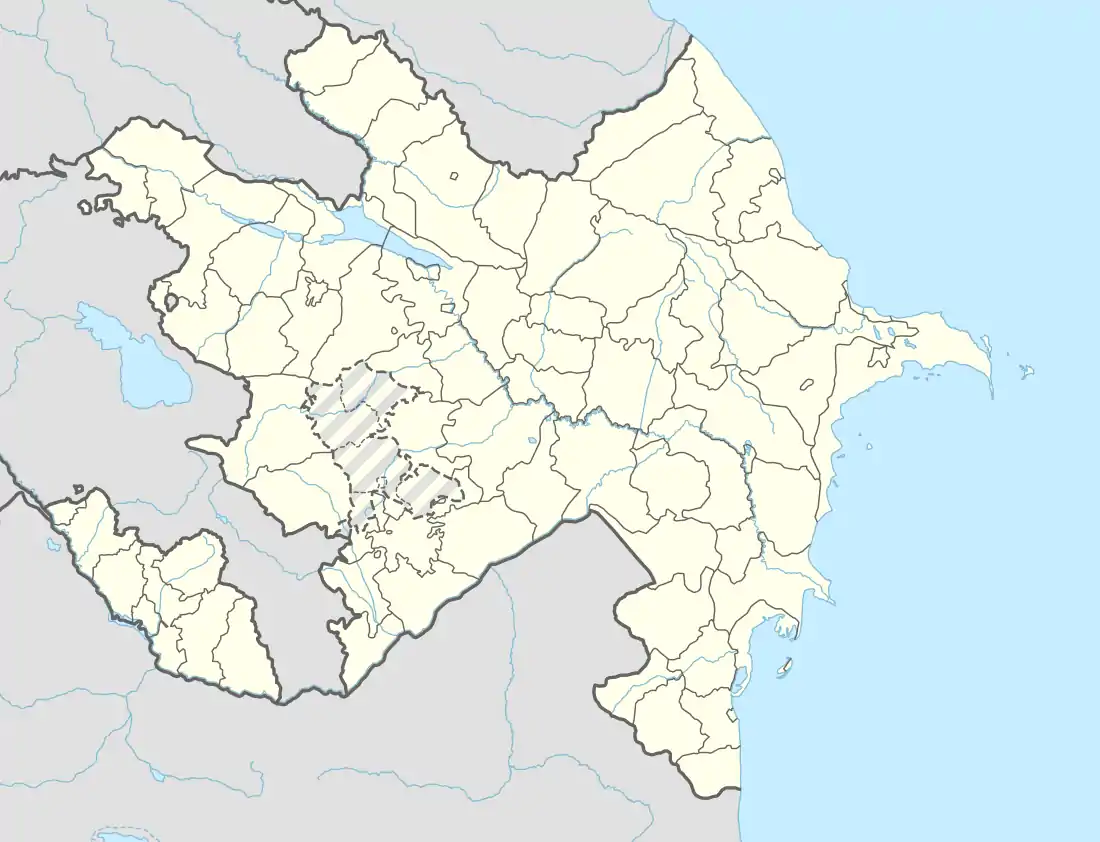Saltaq
Saltaq (also, Saltag and Saltakh) is a village and municipality in the Julfa Rayon of Nakhchivan, Azerbaijan. It is located 30 km in the north from the district center, on the right bank of the Alinjachay River, on the slope of the Zangezur ridge. Its population is busy with vine-growing, farming and animal husbandry. There are secondary school, cultural house, two libraries, club, kindergarten, communication branch, and a medical center in the village. It has a population of 1,566. The monument of Yeycə of the Middle Ages was discovered in the northeast of the village.[1] It had been recorded by the Catholic archdiocese of Nakhichevan that 130 Armenian families in Kırna and Saltaq had converted to Islam in the 1600s and had been Turkified.
Saltaq | |
|---|---|
Municipality | |
 Saltaq | |
| Coordinates: 39°09′08″N 45°39′58″E | |
| Country | |
| Autonomous republic | Nakhchivan |
| Rayon | Julfa |
| Population (2005) | |
| • Total | 1,566 |
| Time zone | UTC+4 (AZT) |
Etymology
The name of the village is related with the name of the same named mountain. And the name of the mountain made out from the components of sal (smooth stone) and taq (an ancient form of the word of "dağ" (mountain)), means "the mountain with the slab stone, the steepness rocky mountain".[2]
Historical and archaeological monuments
Yeycə (Yayja)
Yeycə - the settlement of the Middle Ages in the north-east from the Saltaq village of the Julfa rayon, on the left bank of the Alinjachay River. It is limited by the Alinjachay in the west, with the deep valley in the north and south, with the low hills in the east. Its area is 1850 m2. It was recorded in 1991. The buildings on the monument are completely destroyed, in its place were kept the square and oval pits. The surface materials consists from the products of the glazed and unglazed pottery (fragments of cooked clay pot in the pink and gray colored), clay (jug, bowl-type containers), etc. According to the findings, the place of residence belongs to the 9th-18th centuries; it is believed that there is a cultural layer of the ancient period in here.[1]
Saltaq
Saltaq - the place of residence of the Middle Ages in the east from the same named village in the Julfa rayon, on the left bank of the Alinjachay River. In 1991, the exploration research works were carried out. Its area is 56,000 m2. The place of residence currently divided into two parts through the irrigation ditch; The remains of the building clearly monitored in its north-east. Surface materials, mainly consists from the fragments of clay pot in the pink colored. During the excavation, have been found the casted piles of stone, the fragments of the cooked brick, the remains of the preserved wall in 1 m in length. It is supposed that the Saltaq settlement belongs to the 10h-16th centuries.[1]
Saltaq Necropolis I
Saltaq Necropolis I - the archaeological monument of the Middle Ages in the west from the Saltaq settlement of the Julfa rayon, on the left bank Alinjachay River, on the high hill. In 1991, the exploration research works were carried out. Many of the grave monuments have been destroyed during the farm works. Archaeological cultural relics shows that the Saltaq necropolis belongs to the 14th-16th centuries.[1]
Saltaq Necropolis II
Saltaq Necropolis II - the archaeological monument of the Middle Ages in the north-west from the Saltaq village of the Julfa rayon, on the right bank of the Alinjachay River. It is located in a valley surrounded by mountains on all sides. Part of the cemetery is completely destroyed, the other part currently is used by the local population. The tomb built with the stone in its center, especially attracts an attention. It is supposed that the necropolis belongs to the 14th-16th centuries.[1]
Saltaq Tomb
Saltaq Tomb - the monument of the 14th-16th centuries in the necropolis which located in the north-west from the same named village of the Julfa rayon. It was built with the small stones in the center of the cemetery. Its ceiling has been completed in the crown form; its entrance is protruding to the outward. Also the cooked brick (23х23х5 cm; 20х10х5 cm) were used at the construction of the door (most likely, these bricks associated with its further restoration). Interior walls of the tomb was plastered with alabaster; was collapsed in some places. Inside were discovered the wooden coffin and the remains of a human skeleton.[1]
.svg.png.webp)